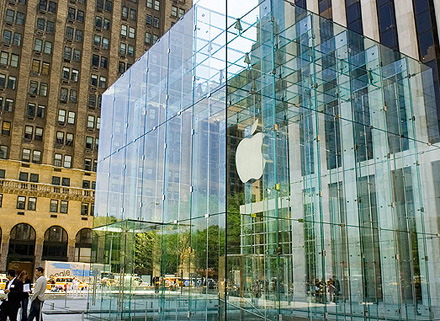Apple’s Q1 revenue for 2012 was a staggering $46.33 billion, a figure that broke all sorts of records. It was the highest revenue the company had ever seen and included the highest profit and highest iPhone sales ever.
$46.33 billion is certainly an impressive number but even more impressive might be $4032.
What is the significance of that last number? That is the amount of sales per square foot of retail space that Apple has been able to make. To put that in perspective, if you were buying the average American home (about 2349 sq. ft.) at that rate, you would need to be ready to spend about $9.5 million. Best Buy is able to squeeze about $930 per sq. ft. out of its retail spaces and Tiffany’s is able to get about $2,666 from its retail space.
 The development of these retail spaces has a lot to do with Steve Jobs’ well-documented control-freak tendencies. Fortunately for Apple, Jobs control was usually a good thing. Conventional wisdom and most of Apple’s competitors said that the Apple store would be a huge failure, but Jobs recognized that the sales channels his company was using were not achieving up to his exacting standards.
The development of these retail spaces has a lot to do with Steve Jobs’ well-documented control-freak tendencies. Fortunately for Apple, Jobs control was usually a good thing. Conventional wisdom and most of Apple’s competitors said that the Apple store would be a huge failure, but Jobs recognized that the sales channels his company was using were not achieving up to his exacting standards.
Jobs had a very keen sense for aesthetics. He believed presentation and appearance were almost as important as the product offerings itself (he was a harsh critic of the poor visual appearance of PowerPoint presentations to the point that he banned them from his meetings). Many Apple employees who gave their boss half-hearted presentations on clunky devices learned this lesson the hard way. Jobs was concerned that his products which he viewed as artistic marriages of beauty and functionality were being presented haphazardly next to clunky, purely utilitarian workstations.
Additionally, the sales staff at most big box stores were woefully undereducated on all of the capabilities of Apple products. Jobs would not suffer fools in his boardroom and he refused to tolerate them on the sales floor.
Finally, Jobs understood his product line. On a spec sheet, iMovie 2 and MovieShaker looked pretty comparable but when you actually start using the programs you find that Apple’s version is much more intuitive and visually pleasing. Those intangibles don’t show up on the spec sheet, but Apple is company that has been built on intangibles.
These factors led Jobs to remove the company’s products from big box stores like Best Buy and Circuit City and eventually create the improbable success story that is the Apple store. The company’s success in retail demonstrates the importance of utilizing the correct sales channels to move your company’s products. You need to be familiar with your company’s offerings to identify whether direct mail, retail or another channel is right for your company. Once you’ve identified how to achieve channel sales, you will know how to target your marketing efforts.
